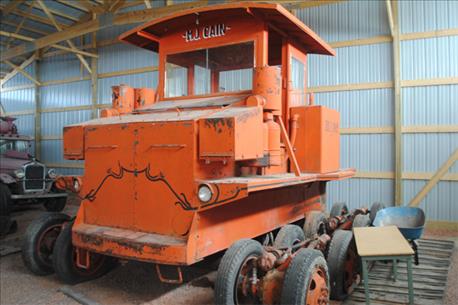
Although Marcus Cain did patent one invention in 1927, the rest of his unique inventions remained unpatented. He was friends with the likes of such agriculture manufacturing legends as the Baldwin brothers, who developed the Gleaner combine. He had offers to go to work for some of the largest machinery manufacturers of the day. But Cain was a Dawes County farmer first, although his career as an inventor came in at a close second.

HISTORY UP CLOSE: The new building and Cain exhibit at the Dawes County Historical Museum at Chadron features the unique inventions of Marcus Cain, a farmer-inventor who developed revolutionary field equipment between 1940 and the late 1960s. Pictured here are volunteers and DCHS board members who worked on the project, including Phyllis Carlson (left), Sharon Rickenbach, Linda Rotness, Roger Wess, Bernard Cripps and Jerry Moss.
The rural Chadron resident developed numerous farm inventions long before anything like them had become commercially available. Cain farmed nearly 4,000 acres of wheat and potatoes in the 1940s through the late 1960s. He sold the farm to the Cullan family in 1971, when he moved to Santa Barbara, Calif. Pat and Jackie Cullan, who live and work on Cain's former farmstead, have been caretakers of the inventions since then.
The inventor
Cain built a 20-foot stubble chopper to reduce residue and make a better seedbed for drilling long before no-till was widely practiced. He built a 24-foot combination self-propelled tiller, drill and packer with track drive and three engines. The unit is complete with rear field lights, long before lighting was common on farm equipment. It was named Marcine, for Cain's daughter. Cain made a 200-hp tractor out of a two-engine World War II tank retriever. When he realized that the tracks on the heavy unit dug up the Panhandle soils when turning around on the field ends, he solved the problem by developing a 16-wheel hydraulically powered drive using tires to run four rubber tracks. He painted it in his signature orange color with black trim, and placed the date of completion, Dec. 1, 1965, on the side.

HOMEMADE TRACTOR: This World War II tank retriever tractor was designed and built by Marcus Cain in 1965. It is now housed in a new Cain exhibit at the DCHS museum, south of Chadron.
This past summer, one of Cain's dreams for his inventions came to fruition. "He always wanted the machinery to be preserved somewhere," Pat Cullan recalls. Cain eventually passed away in California in 1979, but his unique, one-of-a-kind equipment remained in the sheds and grounds on the Cullan farm. Nebraska Farmer visited the Cullan farm a year ago to see Cain's collection up close on the location where the machinery was invented.
A new home
Thanks to hard work and fundraising by local history enthusiasts, agencies, businesses and board members of the local museum, Cain's unique machinery has found a new home at the Dawes County Historical Society museum just south of Chadron. The equipment was moved to its new home — a 60-by-80-foot Cullan-Littrel building. The structure was built around the equipment because the pieces were too big to move in after completion. Along with all kinds of donations, DCHS received a large grant from the Dawes County Travel Board. In August, the Chadron City Council approved $24,260 in LB840 funds for community development to finish out the project. Later that month, a museum ribbon cutting and open house featuring the new exhibit drew a crowd of more than 80 people.
"It seems we've heard many stories since the time we started bringing this equipment to the present location," says DCHS President Sharon Rickenbach. "One gentleman told of a time when he was a youngster and was working for Marcus Cain and driving a 12-cylinder tractor, but Marcus didn't like the way it was running, so he had him stop the tractor. Marcus then pulled out one sparkplug, cleaned it and replaced it, and it ran like a charm," says Rickenbach. "Marcus knew which plug it was by listening to the engine."
She says that Cain must have been a caring person as well. "Another older neighbor told about when Marcus saw smoke coming from his place, he was there in no time to help him put out a fire he had on his combine," she adds.
A key invention, Cain's prototype self-propelled combine, which was considered one of the first of its kind in the nation, was dismantled for parts before the Cullans moved onto the land. A gigantic articulated tractor Cain developed with a front and rear engine was moved to a museum collection outside the region years ago. A combination potato digger, sorter and sacker unit was parted out. So the Cullans and DCHS board members are happy that the rest of the collection can be displayed close to the location where Cain designed his implements.
"These pieces are not only important to Dawes County, but they are historically significant to the agricultural development of the Midwest," says former DCHS President Bernard Cripps. "Marcus enjoyed the process of farming and getting ready to farm, and building machinery to do the job. We are excited to preserve it for everyone to see."
"I don't think it's uncommon for farmers and ranchers to make adjustments to their equipment to fit their needs," says Rickenbach. "However, there are few that I know of that paint and name their creation after they are finished, as Marcus did. The machinery is certainly one of a kind," she adds. "It's the responsibility of a community to preserve such history."
Learn more by contacting the DCHS museum at 308-432-4999.
About the Author(s)
You May Also Like






